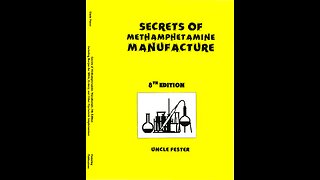Premium Only Content

Synthesis of Natural Cocaine. R. Willstatter, 1923
Welcome to the Dalek Channel.
The year 2023 marks the one hundredth anniversary of the publication of the first paper on the complete synthesis of cocaine. We are pleased to present a translation from the German of the work of Richard von Willstatter, et al.
Synthesis of Natural Cocaine.
Von Richard Willstatter, Otto Wolfes, and Horst Mader.
From the chemical laboratory of the Bayern academy of the sciences in Munich and from the scientific laboratory of the Merck factory in Darmstadt.
Annals of Chemistry volume 434, 1923.
Theoretical Part.
Tropinone Carboxylic Acid Ester.
Psi Cocaine, which is considered to be the racemate of the right-hand cocaine, which occurs in small amounts in the coca plant, was obtained by R Willstatter and M Bormer from intermolecular acetoacetic ester condensation of N-methyl-pyrrolidine di-acetic ester via tropineo-carboxylic acid ester:
The investigation was incomplete with regard to the intermediates and by-products of the synthesis and its completion was important for the knowledge of the stereoisomeric cocaine in chemical and pharmacological terms.
The working materials of the university laboratory seemed insufficient for the continuation of the experiments, especially for the isolation of the isomers that are formed in smaller quantities alongside psi cocaine, and so we have joined forces to continue the experiments on a larger scale in the laboratory of the Merck chemical factory.
The tropinonecarboxylic acid was obtained for the first time more than 20 years ago by the action of carbon dioxide on sodium tropinone, see reference two, and without isolation by reduction with sodium amalgam in a weakly acidic solution to racemic ecgonine.
Page 112:
Also, the intermediate link in the new complete synthesis of cocaine has also not yet been discovered.
Our investigation begins with the isolation of the tropinonecarboxylic acid methyl and ethyl ester, strange compounds that are also analogues of acetoacetic ester and tertiary bases.
They are easy to purify because they are both basic and considerably enolized compounds, possess acidic properties and especially since they already form crystallizing hydrates.
These keto acid esters are more stable than expected; they are inert in terms of hydrogen uptake.
Synthesis of cocaine from Succinaldehyde.
From the starting material of our synthesis, acetone dicarboxylic acid, there is a second route to the tropanderivates. Reference R Robinson, 1917 Soc. 111, published a tropine synthesis of admirable elegance in 1917, modeling it on a condensation carried out by J Thiele, reference 2 Annalen 1909 and 1910, with the phthalaldehyde.
The succindialdehyde reacts with acetone dicarboxylic acid or its ester in the presence of methylamine.
The synthesis was formulated by R Robinson with a dioxopyrrolidine as the first condensation product; but the assumption of this intermediate link is not convincing.
Page 113:
The two carboxyls of acetonedicarboxylic acid were lost in the synthesis of tropinone by Robinson.
The synthesis undergoes a significant expansion if the dicarboxylic acid is replaced by the Eseric acid obtained from Willstatter and Pfannenstiel.
In this case only the free carboxyl is destroyed and the other, the bound carboxyl is spared.
Then this synthetic pathway also leads into the cocaine series.
In this way we obtained the ester of tropinonecarboxylic acid and found it to be identical to the condensation product of methylpyrrolidine diacetic ester.
Two reacemic ecgonins.
For the difficult reduction of the tropononecarboxylic acid ester to the ecgonine ester, the best method has remained the action of sodium amalgam in a solution kept just acidic with hydrochloric acid.
As a by-product, the carboxyalkyl is split off and psi tropine is formed as a by-product of the ecgonine ester not by hydrolysis but by reduction.
Even apart from tropine bases, the reduction product is not uniform.
The beautiful psi ecgonine methyl ester, which has already been described, easily crystallizes out of the oily mixture.
In addition, however, the racemate corresponding to the usual ecgonine ester is formed, which, like the well-known L-ester, cannot be crystallized.
In the previous paper it was already indicated that, in addition to the psi ecgonine ester, an isomer occurs which, according to its behavior, belongs to the ordinary cocaine.
An isomer in the mother liquor was noted.
This second r-Egconine ester is converted to a crystalline hydrochloride and completed by its beautiful benzoly compound been purified, a racemic cocaine which is as close in its characteristics to ordinary cocaine as the already described psi-racemate is to natural cocaine.
Curiously, the two racemates have the same melting point; the mixed sample naturally results in humiliation.
Page 114:
The test for the explanation of the racemates should be the decomposition into the optical opposites.
In the case of r, psi cocaine, however, the cleavage by the classic method of pairing with optically active acids has met with great difficulties, which seem to be based on the unusual stability of semi-racemic salts.
Instead of the benzoyl compound, however, the separation with the d, alpha bromocamphor beta sulphoacid finally succeeded in the case of the corresponding psi ecgonine ester when the fractional crystallization of the salts from ethyl acetate solution was carried out.
The heavy soluble sulphonate is the d-form salt of the right ecgonine ester of melting point 115 degrees described by A Einhorn and A Marquardt.
The l-form can be obtained in pure form from the mother-liquor, more easily when using the second bromocamphor sulphonic acid, the "pi" acid, which together with the l-ester yields a weaker, soluble salt.
The second racemate, which is even more important because of its relation to natural cocaine, can be resolved without difficulty by crystallization of the bitartrate.
The heavy colic salt is that of an oil base, and this has been shown to be identical to natural cocaine.
This completes the synthesis of natural cocaine.
Thus, 2 D and 2 L forms and 2 racemates of the cocaines are available and also really pure.
Third Racemic Ecgonine.
It is the isomers with the cis- and trans-position of the hydroxyl which are present, and with optical isomerism which is based on the neighboring position of the carboxyl in one case to the d- in the other to the L-bridge carrier of the tropine system.
But the number of isomers compiled by Willsatter and Bommer in an overview of the figures is twice as high, since the position of the carboxyl in relation to the tropane segments also causes cis-trans isomerism.
So far there has been little evidence that the carboxyl can be stored in different ways in these amino acids.
Page 115:
Assuming intramolecular saturation of the basic and acidic groups in compounds of the ecgonine type, one is led to the idea that the free amino acid exists primarily in the cis form.
However, J von Braun and E Muller (1) recently succeeded in finding the geometric isomerism caused by the carboxyl in the ester of the tropanecarboxylic acid of hydroecgonidine.
One isomer was known to be the product of the reduction of anhydroecgonine with sodium and alcohol; an isomeric tropane carboxylic acid ester is formed during hydrogenation with palladium and hydrogen, which, according to R Wallstatter and M Brommer (2) and according to J Gadamer and C John (3), requires that anhydroecgonine contains the delta 1 double bond.
A third racemic ecgonine, which differs characteristically from the known ecgonines, has now been isolated in beautiful crystals from the products of the reduction of tropine carboxylic acid ester.
In contrast to the usual ecgonines, it is not rearranged into a psi compound by heating with alkalis, but is converted into racemic anhydroecgonine with the elimination of water.
In this third ecgonine, which will be the subject of more detailed investigation, the cis-trans isomerism based on the arrangement of the carboxyl is realized.
The observation of this isomerism in the free amino acids is consistent with the views of P Pfeiffer (4), which were developed on the basis of the dipole formulas of the amino acids, according to which the intermolecular salt formation of the amino acids and the betaine does not require any spatial approximation of the acidic and basic groups and has nothing in common with ring closure in the usual sense.
Based on this consideration, our previous knowledge cannot determine whether the known ecgonines are the cis-carboxylic acids of the tropanols and the new isomer is trans-carboxylic acids or vice versa.
Pharmacological Results.
The isomeric cocaines described here offer probably unique material for enlightening pharmacological investigations, from which information can be expected with regard to the stereochemical specificity of the anesthetic effect on the nerves, which has received little attention.
Page 116:
Privy Councilor Professor Doctor R Gottlieb has undertaken an in-depth study of these isomers and has been kind enough to provide us with the following summary of the results so far.
The pharmacological study of synthetic cocaine by R Gottlieb of the Pharmacology Institute Heidelberg, published in Archives for experimental Pathology and Pharmacology 1923, has so far shown that the anesthetic capacity on the peripheral nerve elements and the toxic effect in the central nervous system are influenced in different ways by the spatial position of the groups in the cocaine molecule.
This opens up the prospect of finding among the isomers anesthetics that are more effective and at the same time less toxic than leaf cocaine.
The spatial arrangement in the psi series seems to favor the ability to anasthesize.
The strongest effect in direct contact with the nerve elements comes from the d, psi cocaine.
Likewise, the tropacocaine benzoyl psi tropein is superior to benzoyl tropein.
The racemate of the psi series is also more potent than the racemate of ordinary cocaine, but anesthetizes less than its d-part because the L-form is about four times less potent.
Here, the effectiveness also depends on the optical isomerism.
In the case of ordinary cocaine, on the other hand, the potency of the racemate is approximately the same as that of the 2 L and D moieties.
In both series, the D-forms, with gradual absorption from the subcutaneous tissue, prove to be much less harmful to the central nervous system than the left-handed ones.
For example, D, psi cocaine is at most half as toxic as leaf cocaine, while L, psi cocaine is significantly more toxic; the toxicity of the racemate is in the middle.
Likewise, the optical antipode of leaf cocaine has far less resorptive toxic effects than the latter, and accordingly the racemate is already freer from the dangerous side effects of the anesthetic.
Page 117:
Experimental Part.
According to Willstatter and Bommer, the action of sodium dust on the dimethyl ester of N-methyl-pyrrolidin-diacetic acid in Cymol results in a condensation product which is characterized by the intense violet coloration with iron chloride and by the cleavage of tropinone on boiling with dilute sulfuric acid, and was recognized as a beta ketonic acid ester.
The first small-scale experiments had not yet succeeded in preparing this intermediate product in its pure form; According to past observations, its solubility did not appear to be favorable for isolation.
The purification of the ketone acid ester and the similar ethyl compound is, however, facilitated by the formation of hydrates already crystallized.
The condensation product is stirred with a little ice while introducing carbonic acid and the aqueous solution of the sodium salt is separated from the cymol and freed from some starting material and by-products by shaking with ether.
While cooling, one acidifies with hydrochloric acid until Congo paper turns blue, filters and saturates the liquid with potash, in order to then extract the ester from it by shaking it ten times with chloroform.
To purify the basic ester from the chloroform solution we again convert it into 33 per cent sulfuric acid, liberate it with potassium carbonate and isolate it again by extraction with chloroform.
After the solution has been dried with sodium sulphate and evaporated completely in vacuo, an oil remains which, when triturated with a little water and heated, solidifies to form a crystal cake of hydrate.
Dissolved in a little hot water, the hydrate, which is always easily soluble in cold water, separates again in colorless crystal crusts; they first lose the water via phosphorus pentoxide.
The anhydrous ester, which can also be separated from a little methyl alcohol and slowly separates out in tiny crystals, indicates the melting point 111 degrees (correct); the hydrate melts not quite sharply at 100 degrees, releasing water and evaporating some of the substance with it.
Page 118:
To determine the water content, we place the anhydrous substance in a bell over water and then up to consistency in the air.
The anhydrous tropine carboxylic acid methyl ester is readily soluble in ethyl and hot methyl alcohol, considerably soluble in chloroform, very slightly soluble in ether.
It reacts clearly but not with strongly alkaline, and forms salts with both alkalis and acids.
This ketone acid ester was allowed to be strongly enolized in the aqueous solution.
In contrast to tropinone, it is completely resistant to permanganate in dilute sulfuric acid, and its solution is colored strongly red-violet by iron chloride.
Hydrochloride. On addition of ether, crystallize from methyl-alcoholic solution. Nodules consist of six-sided prisms with a melting point of 180 degrees (corrected) beveled at both ends.
Benzoyl compound. The tropinone carboxylic acid ester can easily be benzoylated and, under a wide range of conditions, gives for example B. with and without pyridine or in caustic alkaline solution with benzoyl chloride the same benzoyl derivative, which is suitable for recognizing esters.
For example, we added 4 grams of benzoyl chloride to a solution of 3.5 grams of methyl ester in 6 grams of pyridine.
Page 119:
The mixture warmed up strongly: to complete the reaction let it stand at 30 to 40 degrees.
A sample then gave no more ferric chloride reaction.
After the pyridine had been evaporated off in vacuo, the residue was taken up in water and purified by washing with ether.
We then freed the base with ammonia, shook it out with ether, and on evaporating it obtained a solid residue, which was recrystallized from a benzene solution by mixing it with low-boiling petroleum ether.
The benzoate forms nice needles with a melting point of 75 to 76 degrees (corr)
The benzoylated ester is almost soluble in water, slightly soluble in petroleum ether, and readily soluble in alcohol and ether.
The chloride (melting point 188 degrees, corrected) already crystallizes from ethyl acetate, there is a precipitation with sodium nitrate from the melting point 171 degrees (corrected), also with potassium iodide a poorly soluble iodide (melting point 210 degrees, corrected).
In contrast to cocaine, whose formula contains 2 more H-atoms, the compound does not show any appreciable anesthetic effect.
In sulfuric acid solution, the benzoyl compound behaves almost as if it were saturated with permanganate; it also decolorizes only slowly with bromine.
It resists catalytic hydrogenation and other modes of reduction.
Dilute alkalis and acids readily split off benzoic acid and form tropinone carboxylic acid esters before hydrolysis to tropinone proceeds.
Neither of these observations decides whether the benzoyl has joined the oxygen or a methylene group.
Tropinone carboxylic acid ethyl ester C11H17O3N
The ethyl ester is formed in the Willstätter and Bommer condensation in a somewhat higher yield than the methyl compound (determined as tropinone, 25 percent of theory).
It is liquid and also forms a crystalline hydrate reminiscent of mesoxalic acid ester.
Page 120:
The same does not recrystallize well, but the ester can be purified either via its hydrochloric acid salt or by dissolving it in aqueous potassium hydroxide.
The alkaline solution is washed with ether, to which it gives off no ketone ester, the ester is decomposed with ammonium chloride and shaken out with chloroform.
The anhydrous ester is an oil that distils undecomposed under 0.5 mm pressure at 107 degrees and in small quantities under 25 mm vacuum at about 170 degrees.
The crystallized hydrate melts at 63 to 65 degrees, it is air-stable and gives up all the water over sulfuric acid, at which point liquefaction occurs.
The hydrate is very readily soluble in alcohol, considerably soluble in chloroform in water, and slowly dissolving in ether to the anhydrous form.
With the slow action of moisture on the oily ester, the hydrate also forms as a sublimate in light crystal deposits.
In various solvents, the crystals immediately give an intensive ferric chloride reaction.
The picrate of the tropinonecarboxylic acid ester is sparingly soluble in water and in benzene and melts at 135 to 136 (corrected), the iodomethylate separates from methyl alcohol in tablets of melting point 190 to 192 (corrected), the hydrochloride crystallizes with its alcoholic solution on slow dilution Ather in prisms of melting point 168 degrees (corrected).
Synthesis from acetone dicarboxylic ester acid with succindialdehyde and methylamine.
Here, as in the synthesis of Wilsatter, Pfannenstiel and Bommer, the primary ester of acetone dicarboxylic acid is the starting material.
Page 121:
As Willstatter and Pfannenstiel have observed, Pechmann's diethyl ester is smoothly semi-saponified by alkali at ordinary temperatures and forms a nice dipotassium salt.
The methyl ester acid salt was not yet demonstrated.
We obtained it by adding 156 grams of acetone dicarboxylic acid, dimethyl ester, to a mixture of 800 grams of 50 per cent potassium hydroxide solution and 360 grmas of methyl alcohol cooled to -5.
The salt, which is not a little soluble in methyl alcohol, separates with difficulty; the crystallization is completed by the addition of 150 cc of ether.
Then the dipotassium salt precipitates in snow-white crystalline sheets (98 grams); in alkyl alcohol solution the yield increases but the identity of the primary methyl ester is uncertain.
The synthesis by R Robinson was exemplary for the condensation of the succinaldehyde, obtained by the beautiful method of C Harries, 10 grams was dissolved in 200 cc of water and cooled to -5.
To this we added the ice-cold solution of 41 grams of dipotassium salt in methyl ester acid and of 11.8 grams of methylamine in hydrochloric acid and 16.2 grams of free methylamine in 200 cc of water.
Condensation occurred with an increase in temperature and a soapy mass formed.
After a few hours we acidified the solution with hydrochloric acid, filtered and added an excess of ammonia.
The tropinone carboxylic acid methyl ester, which remained as a brown oil after evaporation, was isolated by frequent extraction with chloroform.
The yield was 15 grams, or 65 percent of theory.
When water was added, the characteristic hydrate formation took place; the crystallized hydrate was purified as described above and characterized by the melting point of approximately 100 degrees, by analysis and specifically by conversion into the two racemic cocaines, the major product, psi-cocaine, melting point 80 degrees, and the minor product, cocaine melting point 79 to 80 degrees.
Some tropinone could be obtained from the mother liquor of the tropinone carboxylic acid ester by boiling with sulfuric acid and isolated as a dibenzal compound.
Page 122:
Resolution of the r, psi ecgonine methyl esters into the optical Isomers.
In the reduction of the tropinonecarboxylic acid methyl ester with sodium analgam in a weakly acidic solution, a mixture of isomeric esters is formed, accompanied by varying amounts of psi-tropine, which is formed by separating off the carboxymethyl.
According to Willstatter and Bommer, the psi-ecgonine ester, which crystallizes very well and is difficult to dissolve, can be easily separated from the mixture in its pure state (melting point 128 degrees).
The r, psi ecgonine resulting from hydrolysis has already been described by R Willstatter and A Bode.
In addition to the anhydrous form mentioned, which crystallizes monoclinically, we also encounter a hydrate with 1 mole of water, which according to Doctor Steinmetz forms tetragonal, bipyramidal prisms (a to c equals 1 to 0.4533).
We tried to split the benzoyl compound of the ester, the racemic psi-cocaine with a melting point of 81.5 degrees, into its components using various optically active acids, namely natural tartaric acid, malic acid, d-camphor sulfonic acid and d-bromocamphor sulfonic acids (beta and pi Acid).
In contrast to the behavior of the racemate of ordinary cocaine, the classical methods failed here, as in the experiments cited by Willstatter and Bode.
In all cases, salts crystallized out which, on decomposition, yielded d, l, psi cocaine and even gave the well-crystallizing, sparingly soluble d, alpha bromocamphor-beta-sulfonate, even when it was protected with bromocamphor sulphonic d, psi cocaine and separated out in fractions, only crystals from which the racemic base has been recovered.
For these, however, the cryoscopic molecular weight determination in benzylic solution gave a simple molecular weight, corresponding to the formula C17H21O4N.
It is not impossible that the salts obtained, which could not be separated by fractional crystallization, are mixtures of compounds of very similar solubility, consisting of the active acid with d- and with l, psi cocaine.
However, the observation does better justice to the assumption that salts of the racemic base with the active acids are present here, i.e. semi-racemic compounds, as some of them were investigated by A Ladenburg.
Page 123:
Since the tendency to break up into the opposites is very low, the conditions for the decomposition could be found.
The compounds of racemic psi-cocaine represent suitable experimental material for further investigations in order to test the views of A Ladenburg and the opposing views of HW Bakhuis Roozeboom with regard to the controversial phenomenon of partial racemy.
Bitartrate des r, psi cocaine. 5 grams of the synthetic base were triturated with 2.5 grams of tartaric acid and dissolved in 35 grams of alcohol with gentle heating.
On careful cooling, rosettes of fine felt-like needles gradually separated out.
After recrystallization from 150 cc of alcohol, the yield was still 6.4 grams; after two consecutive crystallizations from dilute solution we isolated 2.2 grams.
At the same time, the melting point of 164 degrees and the rotation ability did not change.
For hydrochloric d, psi cocaine, i.e. also for the base, we find M equals plus 148 degrees, for the bitartrate of d, psi cocaine (melting point 139 degrees correct) M equals plus 191 degrees, which is M equals plus for d-tartaric acid 43 degrees results.
From the bitartrate of the synthetic alkaloid we isolated the base again, which immediately showed the melting point 79 to 80 degrees, on its own and in a mixture with the starting material.
d, alpha-bromocamphor-beta-sulfonic acid r, psi cocaine. 2.2 grams of synthetic cocaine was dissolved with 2.3 grams of bromocamphor sulfonic acid from HE Armstrong and T M Lowry, in 90 cc of hot water.
On cooling, some syrup separated out, which only crystallized after a long time and frequent rubbing.
Page 124:
The fine-grained salt slowly formed small prisms of melting point 182 to 183 degrees when recrystallizing from water (50 cc).
On the other hand, the bromocamphor sulphonic acid d, psi cocaine crystallized readily from dilute solution in nicely formed clusters of melting point 206 to 207 degrees, corrected.
According to P Walden's rule 452 degrees would be expected.
From the bromocamphor sulfonate of the synthetic alkaloid we also recovered the base, melting point 79 to 80 degrees, which was found to be optically inactive in chloroform solution.
Also the camphorsulfonic acid salt from the r-base (well-formed flakes of melting point 218 degrees corrected, alpha equals plus 9.19 degrees) was quite different from the salt of the active alkaloid (thin needles of melting point 222 degrees corrected, alpha equals 37.31 degrees.
The attempts to split the racemate finally led to success when, instead of cocaine, we paired the d, l, psi ecgonine ester with the d,alpha-bromocamphor-beta-sulphonic acid and allowed the salt to crystallize from ethyl acetate instead of from an aqueous solution.
We dissolved 2.5 grams r, psi ecgonine methyl ester together with 3.8 grams d,alpha bromocamphor-beta-sulphonic acid in hot ethyl acetate and diluted the solution with a little alcohol so that the precipitation of somewhat syrupy salts was avoided during decanting.
Gradually, several millimeter long coffin-lid shaped prisms separate, melting at 198 degrees (corrected 201 degrees).
The crystallographic analysis of the salt was done by Herr Doctor H Steinmetz, who was kind enough to provide us with the following information.
d, psi ecgonine methyl ester-d alpha-bromocamphor-beta-sulfonate (obtained by cleavage of the d, l-ester).
Page 125:
Rhombic bi-sphenoid; a to b to c equals 0.6338 to 1 to 0.3429, Figure 1.
The present crystals showed the following forms: a{100}, m{110} n{120}, p{140}, r{101}.
All the crystals are prismatically parallel to the d-axis; a is only present on a few, m and p often present in a few, m and p often of about the same size, n very narrow or absent.
Only the form r{101} was observed as the end faces of the prisms. The [001] zone is mostly striped and tends to form venal flats.
Cleavage: perfect after {100}. The plane of the optical axes is {100}, the pointed bisectrix is the c-axis. Axis angle for blue smaller than for red. Optically positive.
The surface formation is holohedral; the etching figures on r, however, prove that it belongs to the bisphenoid class.
For comparison, we prepared a preparation of the d, psi methyl ester from natural l-ester by rearrangement, which took place on heating with potassium hydroxide solution, and by re-esterification, and found a corresponding value for the specific rotation.
The methyl ester isolated from the bromocamphor sulfo acid salt crystallized well from ethereal solution and showed the melting point 115 degrees, 116 corrected, alone and in a mixture with natural d, psi-methyl ester (melting point, 115 degrees, according to A Einhorn and A Marquardt).
Mixing with the racemic ester lowered its melting point from 128 to 112 degrees.
The description of the d, psi ecgonine methyl ester should be supplemented with the value for the ability to rotate, which was determined on the natural preparation.
Page 126:
During the cleavage, we also obtained the l-form of the psi-ecgonine methyl ester from the mother liquor of the bromo-campersulfonate, which also melted at 115 degrees and which, together with the same amount of d-ester, gave the racemate of corrected melting point of 129 degrees.
Both components of psi-cocaine have thus become accessible to the Sunthesians, and we have presented both the compound corresponding to natural "legal cocaine" and its antipode, l, psi-cocaine, in pure form.
The preparation of the compounds of the l, psi-ecgonine series is improved by the use of the second bromocamphor sulphonic acid, which gave the opposite result in the decomposition of the racemic ester.
We obtained the l, psi-methyl ester in the form of a sparingly soluble salt when we combined the racemate with the d, alpha-bromocamphor-pi-sulfonic acid of FS Kipping and W J Pope and the salt, separated (without separation) from concentrated alcoholic solution, from hot Methyl alcohol slowly crystallize.
The salt, which melted at 243 degrees (alpha equals plus 43.47 degrees), was broken down to yield the pure l, psi methyl ester (alpha equals minus 14.74 degrees in a 10 percent methyl alcohol solution).
Mister F Müllbauer had the kindness to repeat for us in the institute of Mister Geh. Council's measurement made by Groth:
L, Psi ecgonine methyl ester-d alpha bromo camphor pi sulfonate. Rhombic bisphenolic, a, to b to c equals 0.3598 to one to 0.6692. Simple combination {011},{110}, more rarely {011},{101},{110}, figure two in text.
Page 127:
Cleavage after 011 eng. optical axis plane 001; One axis emerges on each of the surfaces of the prism III. Blunt Bisectrix on (100), Pointed Bisectrix (010); however, this plane does not appear in any of the crystals present.
Iodomethylates of ecgonine esters.
The iodomethylate of the d, psi-methyl ester, whether from the synthetic or the natural ester, undiluted or prepared in solution, melts at 209 degrees.
It is sparingly soluble in cold methyl alcohol and crystallizes in shimmering flakes.
We observe the formation of the same compound as a result of a peculiar rearrangement when iodomethyl acts on undiluted l-ecgonine methyl ester in the cold.
Strangely enough, undiluted l-ecgonine ester in the heat, also with rearrangement, gives rise to an iodomethylate (short needles, poorly soluble in cold wood spirit), which has the properties specified by A. Einhorn and A. Friedlander for right-ecgonine methyl ester (von Wilstatter and Bode ) quoted melting p. 165 degrees has alpha equals plus 11.25 degrees in 5 percent solution.
These still unexplained isomeric relationships invite further investigations.
Under all experimental conditions, the r, psi-methyl ester gives the solid needles or rods of melting point described by Willstater and Bode. 185 degrees, corrected crystallizing compound.
Page 128:
The same iodomethylate we observe as the product of the action of iodomethyl on the undiluted r-methyl ester of the ordinary ecgonine series.
On the other hand, we obtained the true l and d, l ecgonine methyl ester iodomethylates, accompanied by the hydroiodic acid salts, by treating the esters dissolved in methyl alcohol, chloroform or ethyl acetate with iodomethyl.
The l-iodomethylate melts at 164 degrees (alpha equasl minus 17.6, minus 18.2 in 5 percent solution), the d, l iodomethylate, easily soluble in wood spirit, geodes of bevelled rods, at 162 degrees.
The similarly melting iodides are definitely different, as their mixed melting points have also shown.
The iodomethylates of the psi series also differ from the isomers in their greater resistance to alkalis.
r Ecgonine methyl ester, C10H17O3N.
The reduction product of the tropinone carboxylic acid ester is not uniform.
The crystallized psi ecgonine methyl ester leaves an oily portion in the mother liquor.
From this we isolated an isomeric ester in the form of uniformly crystalline hydrochloric acid salts, which is similar in its properties to the natural ecgonine methyl ester, which is also only obtained as an oil.
The chlorohydrate crystallizes from the methyl-alcoholic solution of the r-ethyl ester after neutralization with ether containing hydrochloric acid. Corrected melting point 195.
Page 129:
The best form for purification and characterization of the ester is its benzoyl compound.
Their uniformity proves the purity of this methyl ester, which in the mother liquor of Psi compound is accompanied by other reduction products.
Rearrangement of the r-ecgonine ester to psi racemate.
Like L-ecgonine in so-called right-ecgonine, racemic ecgonine is rearranged by alkali solution into the r, psi-ecgonine described by Willstatter and Bode.
The assumed configuration relationship and analogy with trope and psi-tropion is thereby confirmed.
3.4 grams of oily ecgonine methyl ester were mixed with 12 grams of 33 per cent Potassium lye heated for 24 hours at the reflux condenser.
Then we neutralized the solution with hydrochloric acid, clarified with charcoal and evaporated in vacuo.
The organic substance was removed from the salt residue by boiling with wood spirit and, after repeated evaporation, which was necessary for complete drainage, esterified by boiling for one day with 10 percent methyl alcohol hydrochloric acid.
From the ethereal solution of the ester formed, 2 grams of small colorless prisms separated out, which had a corrected melting point of 128 degrees and were identical to r, Psi ekgonine methyl ester.
The iodomethylate of melting point obtained from a methyl-alcoholic solution of the components. 182 degrees (corrected 185 degrees) and the benzoyl compound, which melted at 80 by itself and when mixed with a preparation prepared from Tropinone according to Willstatter and Bode, confirmed the identity.
R-Cocaine C17H21O4N.
The oily ecgonine ester was diluted with an equal amount of benzoyl and refluxed with two and a half times the weight of benzoic anhydride for 4 hours.
We then diluted it with ether and treated the solution with aqueous hydrochloric acid until it reacted acidically on Congo paper.
The separated chloral hydrate solution was freed from benzoic acid by etherification and made ammoniacal.
Page 130:
We then isolated the alkaloid with ether, in which it is readily soluble, and obtained, on evaporation, a syrup which rapidly crystallized when solidified.
When recrystallized from petroleum ether, in which it readily dissolves when heated, it formed well-formed, flat rhombic prisms of melting point 79 to 80.
So the new racemate has the same melting point as r, psi cocaine, but the bulk sample shows a drop of about 20 degrees.
The crystals of the r-cocaine has Doctor H Steinmetz measured and he has thanked us by kindly communicating the following description.
D, L cocaine Synthetic racemate Rhomical bipyramidal, a-to-b-to-c equals 0.6192 to 1 to 0.6223, figure three in text.
The preparation, crystallized from ether, showed crystals with a diameter of up to 1 cm and the following shapes:
“a”{1, 0, 0}, b {0, 1, 0}, C{0, 0, 1}, m{1, 1, 0}, c{1, 1, 1}.
The crystals are usually thick-slabbed after this plane because of the predominance of b; a greater than b is rarer; c is always small and often absent, and m is not present in all crystals.
The surface finish is not good, surfaces covered with many bumps are always formed, even with slow crystallization.
The values given are mean values from individual readings which deviate from the mean by up to 1 1/2 degrees on either side.
Cleavage: very perfect after b, a little less after c, clearly after a.
The plane of the optical axes is {0, 1, 0}. The angle of the optical axes is very close to 90 degrees; therefore the interference pattern of the pointed bisectrix visible through slits of “c” {0, 0, 1} can hardly be distinguished from that of the blunt bisectrix visible through slits to “a”{1, 0, 0}. Optically positive.
Page 131:
In terms of its properties, r-cocaine is closer to ordinary cocaine than so-called Right cocaine and psi-racemate.
The hydrochlorate is easily soluble in water and alcohol and forms rhomboform tablets when recrystallizing from the latter, in which, according to information from Mister F Mullbauer (Institute d Hrn, Professor von Groth), complicated twin intergrowths of very strongly birefringent biaxial crystals are present. Corrected melting point 187 degrees.
While the two psi bases form sparingly soluble, readily crystallizing nitrates, the r-cocaine nitrate is easily soluble and precipitates from conc. solution oily.
The iodide and the sublimate double salt also show the same differences from the psi series.
Only the permanganate of the new base is notable for its poor solubility and crystallizes well.
The iodomethylate is sparingly soluble in wood spirit, it melts like L-cocaine iodine methylate at 169 degrees (corrected) [melting point of the d, psi-cocaine iodine methylate 172 degrees (corrected), the r, psi compound 213 degrees (corrected)].
Cleavage of r-cocaine into its opposites.
We prepare bitartrate from synthetic alkaloid (3 grams) by dissolving molecular amount (1.5 grams) of d-tartaric acid in hot water (20 cc).
On slow cooling over several days, the salt crystallized in rhombic bisphenoidal prisms (“a” to “b” to “c” equals 1.5611 to 1 to 0.7054) with only holohedral shapes.
The bitartrate, upon recrystallization from water, yielded well-formed prisms that melted at 114 to 115 degrees and contained 2 moles of crystal water.
The bitartrate prepared from natural l-cocaine for the visual comparison showed the flat crystalline form and the same melting point.
Synthetic Cocaine Bitartrate (With two H2O incuded).
Page 132:
Bitartrate of natural cocaine.
The two preparations therefore show the same sense and approximately the same ability to rotate.
We converted the bitartrate obtained from synthetic racemate from melting point 80 degrees into the free base.
It crystallized very well from ether to form flat prisms that melted at 97 to 98 alone and when mixed with natural cocaine.
This gives alpha equals minus 16.15, while O Antrick found for natural cocaine in chloroform solution:
Alpha equals minus 16.412
The salt precipitated from the alcoholic solution of the alkaloid with essential hydrochloric acid had the corrected melting point of 192 degrees.
Since the still unknown d-base, which is important for pharmacological testing, could not be obtained in sufficiently pure form from the mother liquor of l-cocaine d-bitartate, we isolated the antipode of this salt using l-tartaric acid, which we prepared from grape acid with cinchonine.
5.6 grams of d, l base with 2.8 grams of l-tartaric acid dissolved in 18 grams water with heating yielded 5.1 grams on cooling, after recrystallization 4.0 grams d-cacaine-l-bitartrate from melting point 112 degrees.
Page 133:
The base isolated from this salt crystallized from ether in beautiful monoclinic prisms of melting point 98 degrees.
In Groth's Chem. Krystallographie (1919) the axial ratio calculated by Tschermak by Steinmetz is given. Since the recently reported crystallizations of synthetic oil such as d-cocaine showed excellent agreement of the values, a recalculation of the elements was necessary, especially since the value of beta differed considerably from the older measurements.
As the following overview shows, there is complete identity between synthetic and natural cocaine.
Natural L-cocaine “a”{1,0,0}, c{0,0,1} rho {1,0,1-bar}, q{0,1,1}, Chi{0, 1-bar, 1}, omega{1,1, 1-bar}.
Tschermak gave the form {1, 1, 1-bar} instead of {1, 1-bar, 1-bar}. But there seems to be an error in this; This form was observed neither in the preparations presented nor in the preparations recrystallized from them, but the characteristic sphenoid on d-cocaine.
Synthetic L cocaine: also Figure 4 in text.
Synthetic D cocaine: same as Figure 5 in text.
The habit of the crystals obtained from alcohol is mostly tabular to c, usually somewhat elongated parallel to the b-axis.
Page 134:
From petroleum ether you get very long lineal forms of c predominantly with a, and rho, at the ends only q and Chi.
Instead of omega, omega prime should be used for d-cocaine. All preparations show perfect cleavage after {0,0,1}. The plane of the optical axes is perpendicular to the plane of symmetry. The obtuse bisectrix is at an obtuse angle beta, including about 40 with the alpha axis.
The etching figures (Figure 6) on {0, 0, 1}, {1, 0, 0} and {1, 0, 1} are mirror images of the same on the crystals of the optically opposite bodies; the clearest are those obtained with alcohol on the cleavage planes {0, 0, 1}.
r-Ecgonine, C9H15O3N.
In the investigation of R Wilstatter and A Bode, the crude sodium salt of tropinonecarboxylic acid formed from sodium tropinone with carbon dioxide was the starting material for the partial synthesis of r, Psi cocaine.
In addition to psi-ecgonine, an isomer was observed from which Willstatter and Bode were able to isolate psi-tropine by heating with hydrochloric acid.
Therefore, the by-product was assigned the constitution of a psi-tropine-O-carboxylic acid. This information contained errors that need to be corrected.
Page 135:
It would be premature to claim that psi-tropine-O-carboxylic acid does not exist, but the information about the isolated compound, and especially the description of the crystals, including the hydrochloride, does not indicate a compound with the constitution of O-carboxylic acid but it applies to the isolated racemate of the usual ecgonine, which Willstatter and Bode already had in their hands.
If an easily decomposable O-carboxylic acid yielding psi-tropine was formed, then d,l-ecgonine was also a component of the reduction products and this was isolated as the slightly soluble hydrochlorate on separation and as the trihydrate on removing the hydrochloric acid with silver oxide .
Thus d, l, psi-ecgonine and d, l-ecgonine are formed from tropinone according to the method indicated.
We carried out the hydrolysis of our d, l, cocaine or the corresponding ecgonine methyl ester by standing with barite water at room temperature for a week.
After precise precipitation of the barium with sulfuric acid, we evaporate the solution several times with alcohol and repeatedly crystallize the residue from around 90 percent alcohol.
Ecgonine is much more sparingly soluble in cold alcohol than in warm; it crystallized with 3 moles of water in lustrous six-sided plates, which, according to Doctor H Steinmetz are monoclinic and identical to those of the trihydrate measured by him twenty years ago.
The hydrous substance melts vaguely between 93 and 118 degrees, redissolves and melts again and decomposes at about 212 degrees (rapidly heated), with slow heating already at about 203 degrees.
Of the salts, the hemichlorohydrate (C9H15O3N)2HCl is particularly characteristic. It is very sparingly soluble in ethyl and methyl alcohol and crystallizes anhydrous in tablets with a melting point of 247 degrees (with decomposition).
Page 136:
The chloroauric salt, on recrystallization from hot water, formed cross-shaped needles of melting point 205 degrees.
Third racemic Ecgonine (cistrans-isomeric Tropanol-carboxylic acid).
In the reduction of the tropinonecarboxylic acid ester, the crystallizing psi-ecgonine ester and the oily ecgonine ester, the hydrochloride of which crystallizes well, were accompanied by by-products which varied in quantity and composition.
It was possible to isolate another racemic ecgonine from it by hydrolysis with water, a geometric isomer of the two known racemates which differs from them in the position of the carboxyl.
The new ecgonine crystallizes from water on the addition of alcohol, or from hot water, in which it is very readily soluble, in beautiful centimeter-sized prisms, containing 2 moles of crystalline water, and melting at 110 degrees with loss of water; the substance solidifies on further heating and melts again at 225 degrees (229 corrected) with foaming.
The compound shows the resistance to permanganate in sulfuric acid solution, which is due to ecgonines.
For the determinations 1, 3, 6, 7, samples from one presentation, for 2, 4, 5, and 8 from another presentation were used.
The crystals, which are quite different from the forms of the well-known ecgonines, were measured by Mister F Mullbauer in the Groth Institute: we owe him the following information.
Page 137:
Third r-Ecgonine (with two H2O crystals).
Pedial trickling. Approximate axes “a” to “b “to “c” equals 1.2492 to 1. Axis angle alpha equals 58 degrees 50'; beta equals 122 degrees, 7'; gamma equals 113 degrees 2'.
Combination of the present c-axis prismatic crystals {001}{100}{1 bar 10}{010}{1 bar01}{0 1 bar0}{1 1 bar0}.
Among the crystals there are some with mirror images of the opposite formation (Figures 7 and 8 in the text)
The hydrochloric acid (C9H15O3N.HCl.H2O) is very sparingly soluble in alcohol; compact crystals from melting point 230 to 233 degrees.
The new ekgonine suffers when boiled with conc. alkalis not isomerization, but dehydration; a new anhdroekgonin, namely the racemic one, is formed in the same way as in the case of treatment with glacial hydrogen chloride.
We also obtain the same r-anhydroecgonine from d,l, ecgonine by the action of glacial acetic acid-hydrogen chloride in the heat, and, although with more difficulty, also from and d,l psi-ecgonine.
It forms a well-crystallized perbromide and peroxide, and it immediately decolorizes permanganic acid in sulfuric acid solution; It absorbs the molecular amount of hydrogen via the catalytic hydrogenation.
Page 138:
Page 139:
This r-anhydroecgonine, whose double bond is located in delta according to R Willatatter and M Bommer and according to J Gadamer and C John:
It is easily soluble in water, sparingly soluble in cold alcohol; it crystallizes with 1 mole of H2O and melts, previously sintering, at 226 to 230 degrees with decomposition. The methyl ester iodomethylate melts at 180 degrees.
-
 13:47:30
13:47:30
PukeOnABook
20 days agoSecrets of Methamphetamine Manufacture, by Uncle Fester
931 -
 2:27:53
2:27:53
Laura Loomer
5 hours agoBREAKING: MTG Resigns From Congress, Mamdani Meets Trump
48.8K75 -
 LIVE
LIVE
PandaSub2000
1 day agoLIVE 10:30pm ET | BUZZ/DISNEY TRIVIA NIGHT with YOU!
253 watching -
 15:23
15:23
T-SPLY
9 hours agoBUSTED Assistant Principle And Brother Arrested For Wanting To Kill ICE!
18.8K10 -
 22:06
22:06
Jasmin Laine
10 hours agoCBC STUNNED Into SILENCE After JD Vance’s BRUTAL Message to Canadians
13.8K11 -
 2:04:27
2:04:27
TimcastIRL
8 hours agoAntifa CONVICTED Of TERRORISM, Fears Of CIVIL WAR Grow | Timcast IRL
239K82 -
 2:16:43
2:16:43
TheSaltyCracker
6 hours agoIt's Over Zelensky ReeEEStream 11-21-25
81.3K128 -
 LIVE
LIVE
Drew Hernandez
23 hours agoMIKE HUCKABEE EXPOSED FOR OFF RECORD MEETING WITH CONVICTED ISRAELI SPY?
1,028 watching -
 4:07:43
4:07:43
SynthTrax & DJ Cheezus Livestreams
16 hours agoFriday Night Synthwave 80s 90s Electronica and more DJ MIX Livestream SYNTHWAVE / ANIME NIGHT
33.5K1 -
 14:25
14:25
Tactical Advisor
14 hours agoReal Life John Wick Suit | Grayman & Company
21.4K2